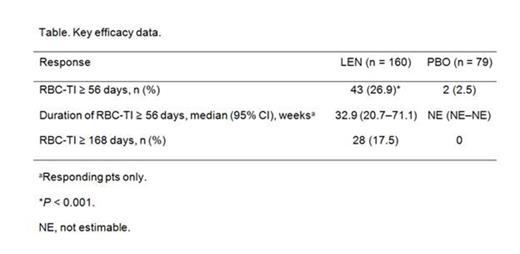Abstract

Background: Treatment options for RBC-TD pts with lower-risk MDS without del(5q) who are unresponsive or refractory to ESAs are very limited. In a previous phase 2 study, MDS-002 (CC-5013-MDS-002), LEN was associated with achievement of RBC-transfusion independence (TI) ≥ 56 days in 26% of pts with IPSS Low/Int-1-risk MDS without del(5q) (Raza et al. Blood 2008;111:86-93). This international phase 3 study (CC-5013-MDS-005) compared the efficacy and safety of LEN versus PBO in RBC-TD pts with IPSS Low/Int-1-risk MDS without del(5q) unresponsive or refractory to ESAs.
Methods: This multicenter, randomized, double-blind, parallel-group phase 3 study included RBC-TD pts (≥ 2 units packed RBCs [pRBCs]/28 days in the 112 days immediately prior to randomization) with IPSS Low/Int-1-risk MDS without del(5q), who were unresponsive or refractory to ESAs (RBC-TD despite ESA treatment with adequate dose and duration, or serum erythropoietin [EPO] > 500 mU/mL). Pts were randomized 2:1 to oral LEN 10 mg once daily (5 mg for pts with creatinine clearance 40–60 mL/min) or PBO. Pts with RBC-TI ≥ 56 days or erythroid response by Day 168 continued double-blind treatment until erythroid relapse, disease progression, unacceptable toxicity, or consent withdrawal. The primary endpoint was RBC-TI ≥ 56 days (defined as absence of any RBC transfusions during any 56 consecutive days). Secondary endpoints included time to RBC-TI, duration of RBC-TI, RBC-TI ≥ 168 days, progression to acute myeloid leukemia (AML; WHO criteria), overall survival (OS), and safety. Baseline bone marrow gene expression profiles were evaluated according to the Ebert signature (PloS Med 2008;5:e35) identified as predictive of LEN response. Clinical trial identifier: CT01029262.
Results: The intent-to-treat population comprises 239 pts (LEN, n = 160; PBO, n = 79). Baseline characteristics were comparable across treatment groups; median age 71 years (range 43–87), 67.8% male, and median time from diagnosis 2.6 years (range 0.1–29.6). Pts received a median of 3.0 pRBC units/28 days (range 1.5–9.8) and 83.7% received prior therapy, including ESAs (78.7%). Significantly more LEN pts achieved RBC-TI ≥ 56 days versus PBO (26.9% vs 2.5%; P < 0.001; Table). The majority (90%) of pts with RBC-TI ≥ 56 days responded within 16 weeks of treatment. Median duration of RBC-TI ≥ 56 days was 8.2 months (range 5.2–17.8). Baseline factors significantly associated with achievement of RBC-TI ≥ 56 days with LEN were: prior ESAs (vs no ESAs; P = 0.005), serum EPO ≤ 500 mU/mL (vs > 500 mU/mL; P = 0.015), < 4 pRBC units/28 days (vs ≥ 4 pRBC units/28 days; P = 0.036), and female sex (vs male; P = 0.035). RBC-TI ≥ 168 days was achieved in 17.5% and 0% of pts in the LEN and PBO groups, respectively. The incidence of AML progression (per 100 person-years) was 1.91 (95% CI 0.80–4.59) and 2.46 (95% CI 0.79–7.64) for LEN and PBO pts, respectively, with median follow-up 1.6 and 1.3 years. Death on treatment occurred in 2.5% of pts on either LEN or PBO. The follow-up period was insufficient to permit OS comparison between the 2 groups. Myelosuppression was the main adverse event (AE); in the LEN versus PBO groups, respectively, grade 3–4 neutropenia occurred in 61.9% versus 11.4% of pts, and grade 3–4 thrombocytopenia in 35.6% versus 3.8% of pts. Discontinuations due to AEs were reported in 31.9% LEN and 11.4% PBO pts; among the 51 LEN pts who discontinued due to AEs, 14 discontinuations were due to thrombocytopenia and 8 due to neutropenia. In the subset of pts evaluated for the Ebert signature (n = 203), the predictive power of the signature was not confirmed.
Conclusions: LEN therapy was associated with a significant achievement of RBC-TI ≥ 56 days in 26.9% of pts with a median duration of RBC-TI of 8.2 months; 90% of pts responded within 16 weeks of treatment. These data were consistent with response rates seen in the MDS-002 trial. The overall safety profile was consistent with the known safety profile of LEN and these data suggest LEN can be safely and effectively used in this patient population.
Santini:Celgene Corporation: Honoraria; Janssen: Honoraria; Novartis: Honoraria; Glaxo Smith Kline: Honoraria. Off Label Use: Trial of Lenalidomide in non-del5q MDS. Almeida:Celgene Corporation: Consultancy, Speakers Bureau. Giagounidis:Celgene Corporation: Consultancy, Honoraria, Membership on an entity's Board of Directors or advisory committees. Vey:Celgene: Honoraria. Mufti:Celgene: Honoraria, Membership on an entity's Board of Directors or advisory committees, Research Funding. Buckstein:Celgene: Research Funding. Mittelman:Celgene: Honoraria, Membership on an entity's Board of Directors or advisory committees, Research Funding, Speakers Bureau. Platzbecker:Celgene: Research Funding. Shpilberg:Celgene Corporation: Consultancy, Honoraria. del Canizo:Celgene Corporation: Consultancy, Research Funding. Gattermann:Celgene: Honoraria, Research Funding; Novartis: Honoraria, Research Funding. Ozawa:Celgene: Consultancy, not specified Other. Zhong:Celgene: Employment, Equity Ownership. Séguy:Celgene: Employment, Equity Ownership. Hoenekopp:Celgene: Employment, Equity Ownership. Beach:Celgene: Employment, Equity Ownership. Fenaux:Novartis: Research Funding; Janssen: Research Funding; Celgene: Research Funding.
Author notes
Asterisk with author names denotes non-ASH members.

This icon denotes a clinically relevant abstract


This feature is available to Subscribers Only
Sign In or Create an Account Close Modal